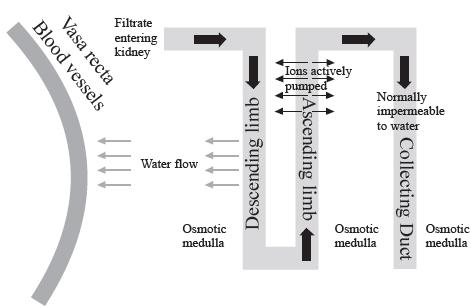The ability to reclaim water from the collecting duct is directly related to the osmotic pull of
Question:
The ability to reclaim water from the collecting duct is directly related to the osmotic pull of the medulla. Kangaroo rats are known to produce extremely concentrated urine. Compared to a human, the nephrons in kangaroo rats must have
(A) Thick walls that are impermeable to water
(B) Shorter Loops of Henle
(C) Longer Loops of Henle
(D) Shorter collecting ducts
The Loop of Henle is a structure within each of the million nephrons within a kidney. As shown in the figure, the two sides have different permeabilities, and there is differential movement across each membrane. The Loop acts as a counter-current multiplier that makes the medulla of the kidney very osmotic. The longer the loop, the higher and more powerful the osmolarity gradient that is created. The gradient is required for the reclamation of water from the urine collecting duct. On the right side of the figure is the urine collecting duct. If the body needs to retain water, anti-diuretic hormone makes this region permeable to water via the introduction of aquaporins, and the osmotic pull of the medulla reclaims the water, out of the collecting duct, which makes the urine more concentrated.
Step by Step Answer:

The Princeton Review AP Biology Premium Prep 2023
ISBN: 9780593450659
2023 Edition
Authors: The Princeton Review





